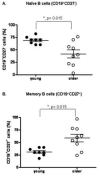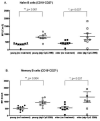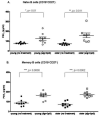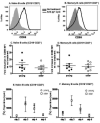Memory B cells from older people express normal levels of cyclooxygenase-2 and produce higher levels of IL-6 and IL-10 upon in vitro activation
- PMID: 20889146
- PMCID: PMC2966539
- DOI: 10.1016/j.cellimm.2010.09.002
Memory B cells from older people express normal levels of cyclooxygenase-2 and produce higher levels of IL-6 and IL-10 upon in vitro activation
Abstract
Worldwide the elderly population is increasing. The elderly show deficiencies in immune function. B lymphocytes are essential elements of the immune system responsible for antibody production. This laboratory previously showed that activated human B cells isolated from young adults express cyclooxygenase-2 (Cox-2) and that Cox-2 is essential for optimal antibody responses. Recent data suggests that Cox-2 expression decreases with age in mouse bone tissue. There is no information regarding Cox-2 expression in B cells from older human subjects. We investigated the expression and activity of Cox-2 in naïve and memory B cells from older people. We show that B cells from older subjects show similar Cox-2 protein expression and activity, antibody production and proliferation compared to younger people. However, we found that activated memory B cells from older people produce higher levels of IL-6 and IL-10 compared to young adults. Therefore, the dysregulated cytokine production could contribute to immune senescence in the elderly.
Copyright © 2010 Elsevier Inc. All rights reserved.
Figures






Similar articles
-
Activated human B lymphocytes express cyclooxygenase-2 and cyclooxygenase inhibitors attenuate antibody production.J Immunol. 2005 Mar 1;174(5):2619-26. doi: 10.4049/jimmunol.174.5.2619. J Immunol. 2005. PMID: 15728468
-
Upregulation of CD72 expression on CD19+ CD27+ memory B cells by CD40L in primary immune thrombocytopenia.Br J Haematol. 2017 Jul;178(2):308-318. doi: 10.1111/bjh.14671. Epub 2017 Apr 17. Br J Haematol. 2017. PMID: 28419421
-
Mincle and human B cell function.J Autoimmun. 2012 Dec;39(4):315-22. doi: 10.1016/j.jaut.2012.04.004. Epub 2012 Jun 12. J Autoimmun. 2012. PMID: 22698596 Free PMC article.
-
Cytokines mediating the proliferation and differentiation of B-1 lymphocytes and their role in ontogeny and phylogeny.Ann N Y Acad Sci. 1992 May 4;651:200-19. doi: 10.1111/j.1749-6632.1992.tb24616.x. Ann N Y Acad Sci. 1992. PMID: 1376040 Review. No abstract available.
-
Aging affects human B cell responses.J Clin Immunol. 2011 Jun;31(3):430-5. doi: 10.1007/s10875-010-9501-7. Epub 2011 Feb 12. J Clin Immunol. 2011. PMID: 21318330 Free PMC article. Review.
Cited by
-
Limited efficacy of inactivated influenza vaccine in elderly individuals is associated with decreased production of vaccine-specific antibodies.J Clin Invest. 2011 Aug;121(8):3109-19. doi: 10.1172/JCI57834. Epub 2011 Jul 25. J Clin Invest. 2011. PMID: 21785218 Free PMC article.
-
Activation of IL-10+ B cells: A novel immunomodulatory mechanism for therapeutic bacterial suspensions.SAGE Open Med. 2020 Jan 15;8:2050312120901547. doi: 10.1177/2050312120901547. eCollection 2020. SAGE Open Med. 2020. PMID: 32002185 Free PMC article.
-
Lipoxin B4 Enhances Human Memory B Cell Antibody Production via Upregulating Cyclooxygenase-2 Expression.J Immunol. 2018 Dec 1;201(11):3343-3351. doi: 10.4049/jimmunol.1700503. Epub 2018 Oct 22. J Immunol. 2018. PMID: 30348736 Free PMC article.
-
Lipoxin A₄ modulates adaptive immunity by decreasing memory B-cell responses via an ALX/FPR2-dependent mechanism.Eur J Immunol. 2014 Feb;44(2):357-69. doi: 10.1002/eji.201343316. Eur J Immunol. 2014. PMID: 24166736 Free PMC article.
-
Vaccine responses in ageing and chronic viral infection.Oxf Open Immunol. 2021 Apr 19;2(1):iqab007. doi: 10.1093/oxfimm/iqab007. eCollection 2021. Oxf Open Immunol. 2021. PMID: 36845567 Free PMC article. Review.
References
-
- Ryan EP, Pollock SJ, Murant TI, Bernstein SH, Felgar RE, Phipps RP. Activated human B lymphocytes express cyclooxygenase-2 and cyclooxygenase inhibitors attenuate antibody production. J. Immunol. 2005;174:2619–2626. - PubMed
-
- Harris SG, Padilla J, Koumas L, Ray D, Phipps RP. Prostaglandins as modulators of immunity. Trends Immunol. 2002;23:144–150. - PubMed
-
- Davies P, Bailey PJ, Goldenberg MM, Ford-Hutchinson AW. The role of arachidonic acid oxygenation products in pain and inflammation. Annu. Rev. Immunol. 1984;2:335–357. - PubMed
-
- Langman MJ. Ulcer complications and nonsteroidal anti-inflammatory drugs. Am. J. Med. 1988;84:15–19. - PubMed
-
- Linton PJ, Dorshkind K. Age-related changes in lymphocyte development and function. Nat. Immunol. 2004;5:133–139. - PubMed
Publication types
MeSH terms
Substances
Grants and funding
LinkOut - more resources
Full Text Sources
Medical
Research Materials

